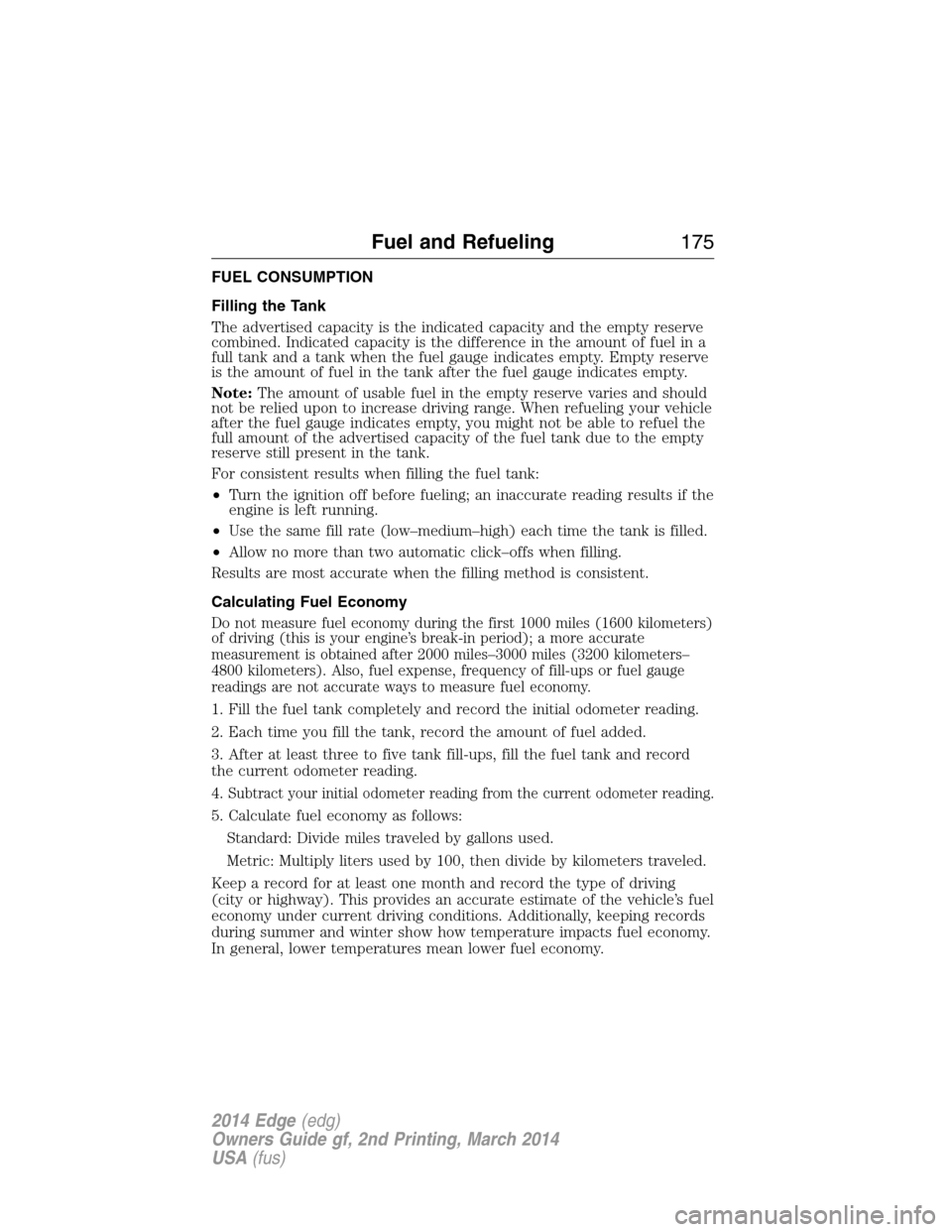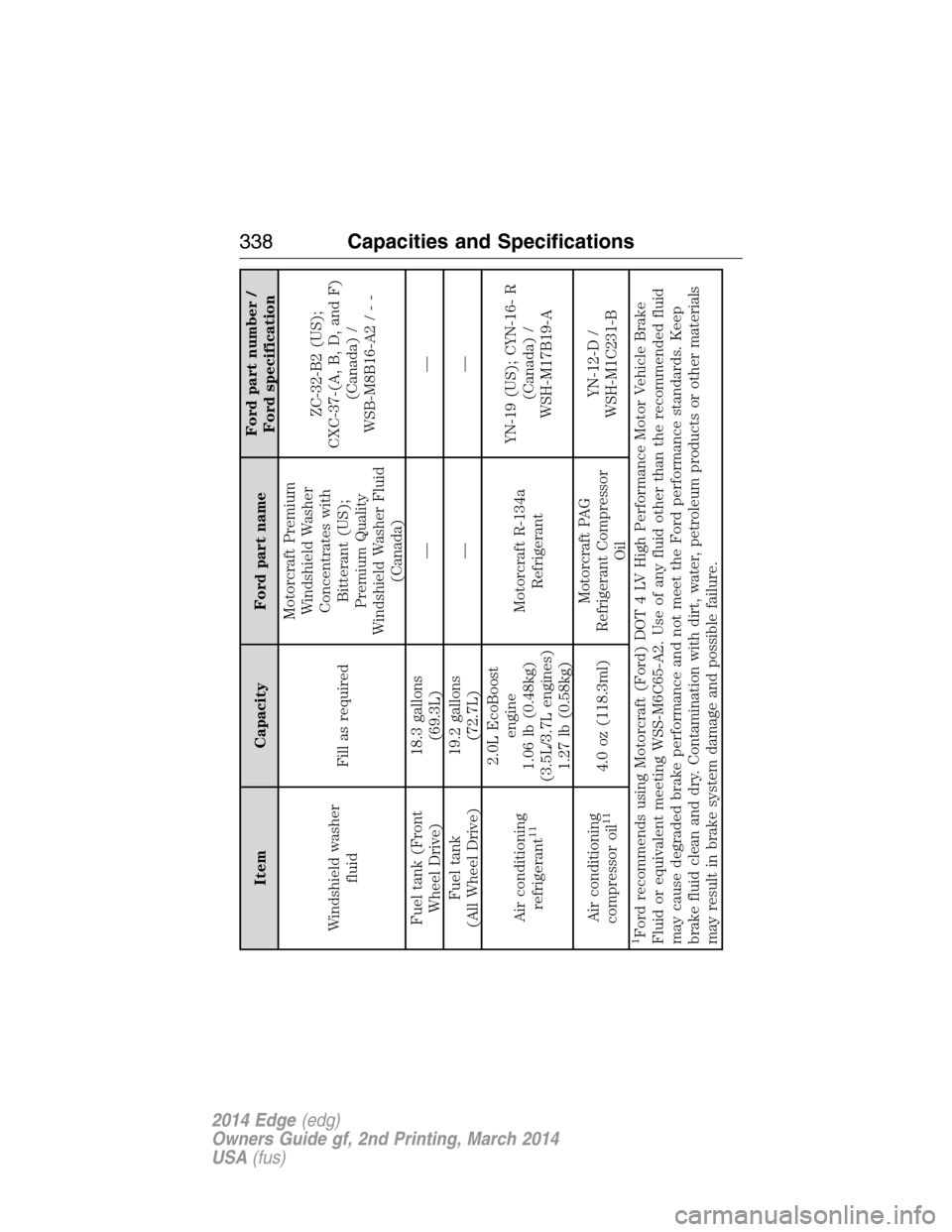fuel tank capacity FORD EDGE 2014 1.G Owners Manual
[x] Cancel search | Manufacturer: FORD, Model Year: 2014, Model line: EDGE, Model: FORD EDGE 2014 1.GPages: 540, PDF Size: 7.52 MB
Page 176 of 540

FUEL CONSUMPTION
Filling the Tank
The advertised capacity is the indicated capacity and the empty reserve
combined. Indicated capacity is the difference in the amount of fuel in a
full tank and a tank when the fuel gauge indicates empty. Empty reserve
is the amount of fuel in the tank after the fuel gauge indicates empty.
Note:The amount of usable fuel in the empty reserve varies and should
not be relied upon to increase driving range. When refueling your vehicle
after the fuel gauge indicates empty, you might not be able to refuel the
full amount of the advertised capacity of the fuel tank due to the empty
reserve still present in the tank.
For consistent results when filling the fuel tank:
•Turn the ignition off before fueling; an inaccurate reading results if the
engine is left running.
•Use the same fill rate (low–medium–high) each time the tank is filled.
•Allow no more than two automatic click–offs when filling.
Results are most accurate when the filling method is consistent.
Calculating Fuel Economy
Do not measure fuel economy during the first 1000 miles (1600 kilometers)
of driving (this is your engine’s break-in period); a more accurate
measurement is obtained after 2000 miles–3000 miles (3200 kilometers–
4800 kilometers). Also, fuel expense, frequency of fill-ups or fuel gauge
readings are not accurate ways to measure fuel economy.
1. Fill the fuel tank completely and record the initial odometer reading.
2. Each time you fill the tank, record the amount of fuel added.
3. After at least three to five tank fill-ups, fill the fuel tank and record
the current odometer reading.
4.
Subtract your initial odometer reading from the current odometer reading.
5. Calculate fuel economy as follows:
Standard: Divide miles traveled by gallons used.
Metric: Multiply liters used by 100, then divide by kilometers traveled.
Keep a record for at least one month and record the type of driving
(city or highway). This provides an accurate estimate of the vehicle’s fuel
economy under current driving conditions. Additionally, keeping records
during summer and winter show how temperature impacts fuel economy.
In general, lower temperatures mean lower fuel economy.
Fuel and Refueling175
2014 Edge(edg)
Owners Guide gf, 2nd Printing, March 2014
USA(fus)
Page 339 of 540

Item Capacity Ford part nameFord part number /
Ford specification
Windshield washer
fluidFill as requiredMotorcraft Premium
Windshield Washer
Concentrates with
Bitterant (US);
Premium Quality
Windshield Washer Fluid
(Canada)ZC-32-B2 (US);
CXC-37-(A, B, D, and F)
(Canada) /
WSB-M8B16-A2/--
Fuel tank (Front
Wheel Drive)18.3 gallons
(69.3L)——
Fuel tank
(All Wheel Drive)19.2 gallons
(72.7L)——
Air conditioning
refrigerant
11
2.0L EcoBoost
engine
1.06 lb (0.48kg)
(3.5L/3.7L engines)
1.27 lb (0.58kg)Motorcraft R-134a
RefrigerantYN-19 (US); CYN-16- R
(Canada) /
WSH-M17B19-A
Air conditioning
compressor oil
11
4.0 oz (118.3ml)Motorcraft PAG
Refrigerant Compressor
OilYN-12-D /
WSH-M1C231-B
1Ford recommends using Motorcraft (Ford) DOT 4 LV High Performance Motor Vehicle Brake
Fluid or equivalent meeting WSS-M6C65-A2. Use of any fluid other than the recommended fluid
may cause degraded brake performance and not meet the Ford performance standards. Keep
brake fluid clean and dry. Contamination with dirt, water, petroleum products or other materials
may result in brake system damage and possible failure.
338Capacities and Specifications
2014 Edge(edg)
Owners Guide gf, 2nd Printing, March 2014
USA(fus)